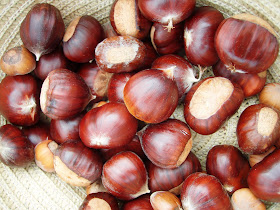 |
| Zesty Orange and Lemon |
Now that it is starting to feel cold at night, I thought it might be a good idea to start making some Winter Warming Wines. I started off with an old favourite flavour of mine, Ginger. Not much foraging involved with this entry but the spirit is just the same.
 |
| Must Get A Lemon Squeezer Geezer |
After pealing the zest off two oranges, two lemons the house was soon humming with exotic aromas and this was soon added to by my boiling the bruised and battered ginger in water and Demerara sugar.
 |
| Add the Rasins and Zest |
I have made ginger wine before and it was very successful but I always feel a little bit mean when I smash the ginger root – I grew one once and it had lovely delicate leaves. I used the Head Chef’s stone pestle to prepare this.
 |
| Sorry! |
We do not have a lemon squeezer apparently, so I cut the remaining skin off the fruit and sliced them into the mixture, this looked as agreeable as it smelled and I then proceeded to crush the juice out with my bare hands.
 |
| Smelling Rather Nice Now |
In a dangerous manoeuvre I combined the boiling hot liquid with the fruity juice in a bucket and left it to cool down. When the mixture was luke-warm, I added the previously activated yeast and left it to ferment.
 |
| Fermenting Away Nicely |
It is now bubbling away like a witches brew in my airing cupboard.
I might also try Rhubarb Wine, if I can collect enough from the garden…




















































